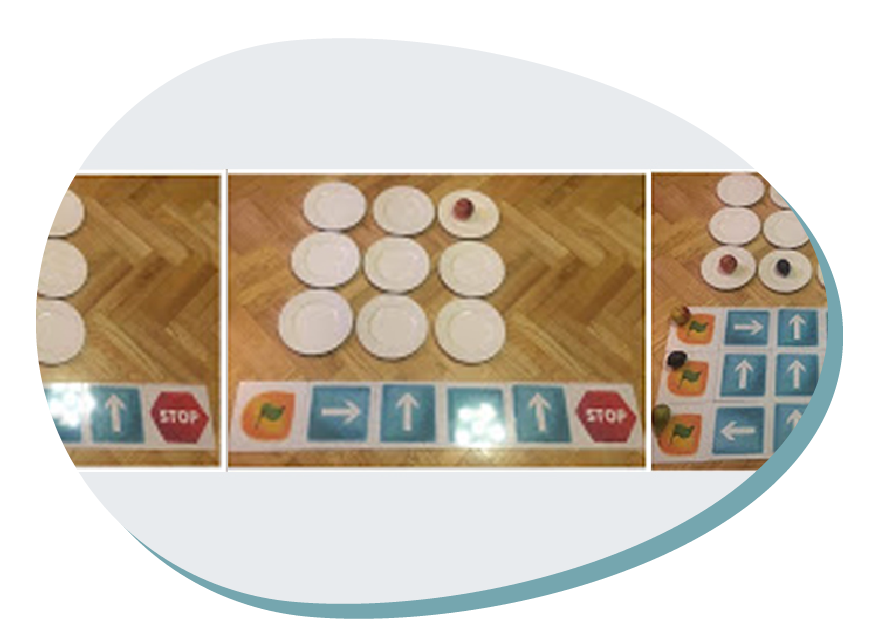Fruit sudoku – coding on plates
Type of resource: Blog: Coding on the carpet
Web address http://kodowanienadywanie.blogspot.com/2016/09/owocowe-kodowanie-na-talerzykach.html
Language: Polish
Description
Observing, analyzing and comparing the features of friuts and vegetables
Classifying fruits according to a given feature
Learning to read and understand information expressed in the form of pictograms (simple graphic symbols).
Scientific concept introduced
Fruits, vegetables, coding, vertical line, horizontal line, concepts and words describing space (over, under, obok, on the right side, on the left, in the middle, in the corner etc.).
Creative and critical thinking
–
Mathematical reasoning
Mathematical reasoning:
– grouping
– classifying and ordering
– spacial orientation
– reading information presented in symbolic form
Scientific thinking
Predicting
Identifying and solving problems
Learning how to learn
–
Additional
Enriching vocabulary
Cooperating in a team (taking common decisions, sharing ideas)
Fine motor skills
Had-eye coordination
Fruit sudoku – coding on plates
Overall aims
To enrich children’s knowledge of fruits and vegetables
To strengthen the ability to observe
To develop the mathematical reasoning (classifying, ordering, segregating, understanding space and dimensions)
To develop logical thinking
To improve eye-hand coordination
To build the ability of reading symbols (understanding information expressed in symbols)
To develop social competences (working in team)
Vocabulary – keywords should be understood
Fruits, vegetables, coding, vertical line, horizontal line, concepts and words describing space (over, under, obok, on the right side, on the left, in the middle, in the corner etc.)
Expected learning outcomes (operational aims)
To name different fruits and vegetables (to link the name to an abject);
To describe characteristic features of fruits and vegetables;
To classify fruits and vegetables according to a given variable/characteristic;
To order fruits according to a given pattern/schema;
To observe and draw conclusions;
To follow the instructions of a teacher;
To understand and explain the information expressed in form of pictograms (simple symbols);
To cooperate in a team.
STEM skills – to which the learning unit is related to
CORE STEM SKILLS
Learning to think and discover (analyzing and comparing, classifying according to a given feature)
Predicting
Identifying and solving problems
ADDITIONAL SKILLS
Cooperating in a team (taking common decisions, sharing ideas);
Fine motor skills: had-eye coordination;
Enriching vocabulary.
Teaching methodologies/activity outline
1. Presenting fruits and vegetables with the question: Do you know these? ; getting to know the names, observing and explaining the characteristics, tasting and searching for the possibilities to use.
2. Fruit Sudoku
Plates can be used as fields to compose sudoku.
Choose 4 types of fruits, vegetables or leaves and compose sudoku while remembering that the same object cannot be repeated neither in horizontal, nor in vertical lines.
For 3 year old children 9 plates are enough, for older children the number of plates can be increased.
How to compose this set of fruits and vegetables on plates to make sure that every fruit or vegetable does not repeat more than once neither in horizontal, nor in vertical order?
3. Next to, on the right, on the left
Plates ad fruits can be also used to strengthen children’s understanding of space and dimensions.
Use the instructions such as: Place the apple on the left side of a pear; Move the plum from the upper left corner to the middle. Tell me where the pear is? Etc.
The level of difficulty should adjusted to the age and possibilities of children
4. Coding on plates
Using the pictograms (symbols of arrows) we can invite children to follow the coded instruction. Scripts can concern a particular type of fruit or vegetable.
Follow the instruction coded in symbols: Go to the right, Go to the left, Go up/ down etc.
Assessment of learning
Summary of class:
How can we classify fruits or vegetables – according to what kind of features?
Do you understand what des it mean: To place an apple below/ above a pear? On the right / on the left side of a pear?
What do you like about fruit sudoku? What did you dislike? What is the easiest part of sudoku?
What is the most difficult?
Equipment and materials to be used in learning unit (tools, ingredients etc)
– A set of plates (identical)
– A set of different fruits and vegetables
– Pictograms
Kind of setting
Classroom or the preschool garden (during summer)
References – source
http://kodowanienadywanie.blogspot.com/2016/09/owocowe-kodowanie-na-talerzykach.html
Fruit sudoku – coding on plates
1. Usefulness for STEM education – integrating content of different disciplines
Cross-curricular character of the resource

The range of S-T-E-M subjects included

The presentation of possibilities of including artistic activities (STEAM approach)

2. Expected learning outcomes
Consistency (links) with preschool core curriculum

Communicativeness of description

3. Methodology of teaching
Clarity, communicativeness of instructions for teachers

Meaningful learning – using practical life problems

Original idea

The level of ease in implementing the methodology to preschool age children

The level of ease in preparing necessary ingredients, materials and equipment needed

4. Sustainability
Ecological characteristics of materials/ results

Supporting healthy eating habits

Low ecological footprint

Possibilities of inclusion (respecting cultural diversity and food intolerances)

5. Class management
Using differentiated forms of work – individual, team work etc.

Individual work

Team work

Whole group
6. Time management

Short activity (10-15 minutes)

Medium activity (20-30 minutes)

Long activity (1 hour or more)

Very long activity (1 day or more)
PDF: https://www.printfriendly.com/p/g/DrZzAt

